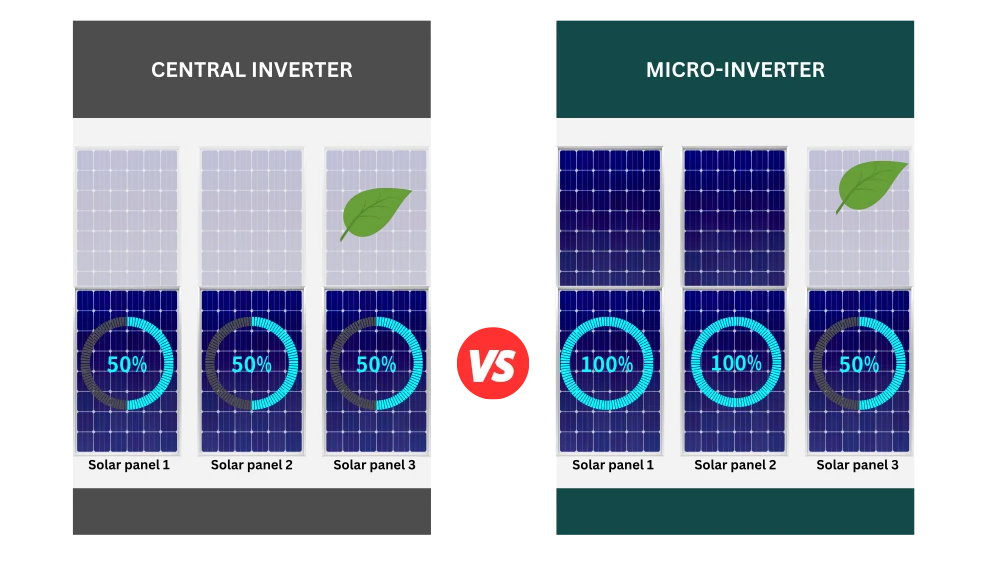We design and install solar panels paired with individual micro-inverters. Unlike central inverters micro-inverters are connected in string. This type of system architecture is a key to many advantages.



Shading, precipitation, roof elements, and debris can impact individual solar panel performance. Central inverters adjust all panels to the least efficient one’s level to optimize the system. In contrast, micro-inverters optimize each panel individually, boosting electricity generation by up to 30%.
When faced with a roof that lacks the optimal shape for traditional solar panel installation, homeowners essentially have two choices: either opt for microinverters, which offer flexibility and efficiency without compromising aesthetics or safety, or resort to potentially unsightly and less secure constructions on the roof to force-fit panels into a less-than-ideal setup.




Our solar stations are built upon a modular design, with each pair of a solar panel and individual micro-inverter forming the basic building block. That is the reason why adding extra panels for increased energy output is effortless.




Most solar installers boast a 25-year warranty on solar panels, yet a solar station includes more than just panels; the overall warranty matches the shortest component warranty, the inverter.
We stand out with a remarkable 15-year warranty on NEP micro-inverters, setting a new standard in the Armenian market.

Do you know that in some US jurisdictions, central inverters are banned?
Micro-inverters swiftly convert solar panel DC power to AC, necessitating an AC cable to the meter board instead of high-voltage DC transmission. Concerns over fire hazards from roof cavity DC cables are evident, particularly if compromised by rodents. Water infiltration into DC isolators, designed for fire safety, is a common issue. Certain US jurisdictions have imposed bans on string inverters.
We will assess roof strength, create 3D models for shading analysis, and use simulation software for solar energy estimates.
We will size the system, customize the design, finalize the contract, and arrange bidirectional meter paperwork.
We'll ensure efficient installation, thorough testing, and cleanup, provide training.
Experience our after-sales support. We monitor your system 24/7, ensuring its optimal performance at all times. Need a cleaning or inspection of your panels? Want to add more panels or find any other effective energy solution? We’re just a call away.
Armenia’s energy demand is on a constant rise, often outpacing the grid’s ability to meet it promptly. Consequently, energy outages are not uncommon in our country. Many resort to manually activating loud and polluting gas generators to sustain their daily lives during these outages. We propose a superior alternative: integrate an EcoFlow backup battery system into your home.


A home backup battery is a versatile device designed to store energy for use during power outages or peak electricity demand periods. They come in various capacities and functionalities, offering flexibility to meet different needs.
These batteries can be stationary, fixed to a wall or freestanding, or portable for on-the-go energy needs.
They can draw power from different sources such as the grid, solar panels, or even a gas generator.
Depending on the setup, they can either integrate with the home grid, allowing you to use power sockets, or operate separately, directly powering appliances. Integrated batteries may feature built-in uninterruptible power supply (UPS) functionality, automatically switching to battery power when the grid goes down, either autonomously or manually controlled. Moreover, advanced energy management systems in integrated batteries intelligently prioritize powering essential loads based on battery charge levels, ensuring efficient energy use.

R-Fab offers the EcoFlow Delta Pro portable home battery. It can be integrated into your home grid via SmartPanel, automatically activating the Delta Pro to power your home grid within just 20 milliseconds of a grid outage. Additionally, it boasts intelligent power management capabilities, prioritizing the supply of electricity to essential appliances based on the battery’s charge level.
The duration a home backup battery can power your house during an outage depends on its capacity and the energy consumption of your appliances.
For instance, the standalone DELTA Pro station has an output power and built-in battery capacity of 3600W. Moreover, the architecture of the DELTA Pro allows for scalability. You can increase the output power by connecting two DELTA Pro stations simultaneously to the EcoFlow Smart Panel distribution panel (up to 7200W). Additionally, you can increase the station’s capacity by connecting additional batteries, up to 25 kWh.
Delta Pro battery can support various household appliances simultaneously. 3600W capacity is enough to: